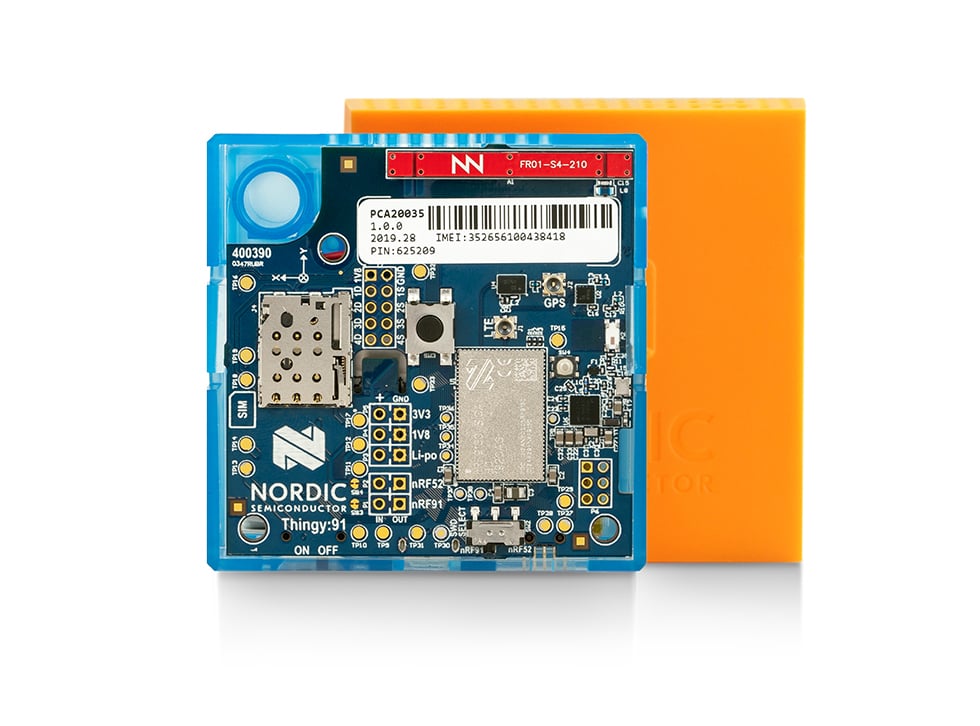Back to articles
Bosch Sensortec BME680: The Nose of Nordic’s Thingy:91

We take a closer look at the Bosch Sensortec BME680, the environmental multi-sensor in the new Nordic Thingy:91 cellular IoT prototyping platform.
Following the success of the Nordic Thingy:52 in slashing prototyping times for Bluetooth Low Energy development, the Nordic Thingy:91 is set to do the same for cellular IoT development. If you’ve wanted to get started with LTE-M and NB-IoT development, this is the prototyping platform for you.
Read more: Simplify Cellular IoT Prototyping With Nordic Thingy:91
While we provide the connectivity, we’ve partnered with Bosch Sensortec to include their excellent BME680 environmental sensor.
I spoke to Omar Elrhoul, Senior Expert Business Development at Bosch Sensortec, about what the multi-sensor does, why they chose to partner with Nordic, and what use cases they foresee.
What’s inside?
Basically, the BME680 is a 4-in-1 integrated multi-sensor, capable of measuring pressure, relative humidity, temperature and gas. The low power sensor is small and adapted for all kinds of battery powered devices. Many devices can already see with a camera and hear with a microphone, but this sensor essentially adds a sense of smell.
What are the main use cases?
We designed the sensor primarily for an indoor air quality use case because it’s a major health and wellbeing topic right now in many parts of the world. One of the challenges in assessing air quality as humans is that we don’t feel changes immediately.
Take the example of when you sit in a meeting room for hours. The air quality deteriorates inside, but no one notices until someone opens the door and steps in. They notice! An air quality sensor helps to monitor this sort of situation and could be used to send warnings to meeting participants or automatically vent rooms.
But we also see many more possible applications. For example, measuring air quality with personal devices like wearables and weather stations, as well as industrial and agricultural applications, asset tracking, and more.
Why did this device get developed?
It all starts from a use case or a market need. Bosch Sensortec is a market leader in consumer MEMS sensors. We’ve made successful motion, pressure and humidity sensors for years, so we decided to extend our portfolio with a new product to look at issues like indoor air quality.
Also there’s been a strong interest from the market. On our Bosch Sensortec online community, the BME680 is one of the most discussed sensors. Specific questions come up regarding how to send and process sensor data in the cloud, which is one of the reasons we decided to look into adding cellular IoT connectivity through the partnership with Nordic.
Why did you choose to partner with Nordic on the Thingy:91?
Adding cellular loT connectivity should enable more outdoor sensor network use-cases. For example, we have some people talking about monitoring forests for fire risks, and there are plenty of smart city use cases such as air quality mapping.
The Thingy:91 is a very good fit for the BME680. Both focus on low-power and Nordic is well-known in the prototyping space.
There’s a lot going on in this device. How were you able to keep the power consumption so low?
The device is low power by design, but we have also added in different power modes to give the user some flexibility depending on the data needs. In addition, we offer a complementary software solution Bosch Software Environmental Cluster (BSEC) available for download from our website.
Based on an intelligent algorithm, the BSEC provides an index of air quality (IAQ) output. The BSEC supports different operational modes to address the necessary power budget and update rate requirements of the end-application.
Furthermore, developers can create software to interpret the raw data from the BME680. A potential application for this could be monitoring gases, temperature and humidity in a container that stores food.
Are there any other interesting elements to this device?
I would like to highlight the pressure sensor, which gives so many possibilities. Measuring pressure can do everything from giving you a more precise step & distance count, to improved GPS and navigation on multi-level highways, bridges and so on. Of course, the Thingy:91 has GPS so there could be some interesting possibilities for development there.
Looking forward, what do you see as the next big trends in sensor technology?
The innovation and variety of use cases continues to grow. With amazing advances in AI too, I think devices will become much smarter. By using edge AI concepts, devices in remote areas won’t just collect data, they will have predictive capability and autonomy built in. This is a very interesting area to explore.


